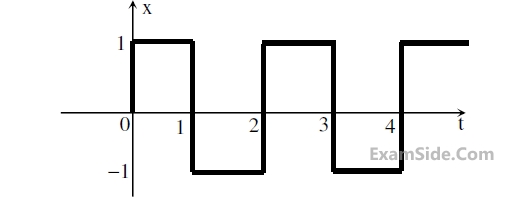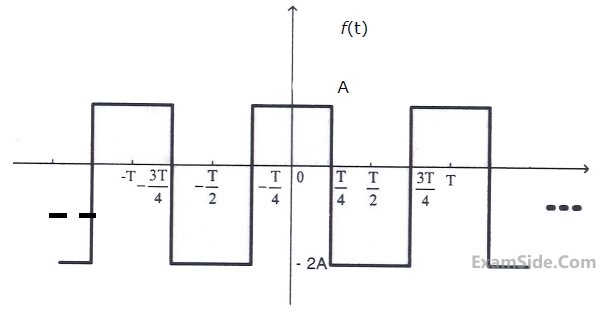Representation of Continuous Time Signal Fourier Series · Signals and Systems · GATE ECE
Marks 1
In the table shown below, match the signal type with its spectral characteristics.
| Signal type | Spectral characteristics | ||
|---|---|---|---|
| (i) | Continuous, aperiodic | (a) | Continuous, aperiodic |
| (ii) | Continuous, periodic | (b) | Continuous, periodic |
| (iii) | Discrete, aperiodic | (c) | Discrete, aperiodic |
| (iv) | Discrete, periodic | (d) | Discrete, periodic |
$$x\left( t \right) = \sum\limits_{k = - \infty }^\infty {{a_k}} {e^{jk{{2\pi } \over T}t}}$$
The same function 𝑥(𝑡) can also be considered as a periodic function with period T' = 40. Let bk be the Fourier series coefficients when period is taken as T'. If $$\sum\limits_{k = - \infty }^\infty {\left| {{a_k}} \right|} = 16$$, then $$\sum\limits_{k = - \infty }^\infty {\left| {{b_k}} \right|} = 16$$ is equal to
 The ratio of the power in the 7th harmonic to the power in the 5th harmonic for this waveform is closest in value to _______.
The ratio of the power in the 7th harmonic to the power in the 5th harmonic for this waveform is closest in value to _______.
P. Cosine terms if it is even
Q. Sine terms if it is even
R. Cosine terms if it odd
S. Sine terms if it is odd
Which of the above statement are correct?Marks 2
Let $f(t)$ be a periodic signal with fundamental period $T_0>0$. Consider the signal $y(t)=f(\alpha t)$, where $\alpha>1$.
The Fourier series expansions of $f(t)$ and $y(t)$ are given by
$$ f(t)=\sum\limits_{k = - \infty }^\infty c_k e^{j \frac{2 \pi}{T_0} k T} \text { and } y(t)=\sum\limits_{k = - \infty }^\infty d_k e^{j \frac{2 \pi}{T_0} \alpha k T} . $$
Which of the following statements is/are TRUE?
Let $$\mathrm{x_1(t)=u(t+1.5)-u(t-1.5)}$$ and $$\mathrm{x_2(t)}$$ is shown in the figure below. For $$\mathrm{y(t)=x_1(t)~*~x_2(t)}$$, the $$\int_{ - \infty }^\infty {y(t)dt} $$ is ____________ (rounded off to the nearest integer).

I. The complex Fourier series coefficients of x(3t) are {ak} where k is integer valued
II. The complex Fourier series coefficients of x(3t) are {3ak} where k is integer valued
III. The fundamental angular frequency of x(3t) is 6$$\mathrm\pi$$ rad/s
For the three statements above, which one of the following is correct?